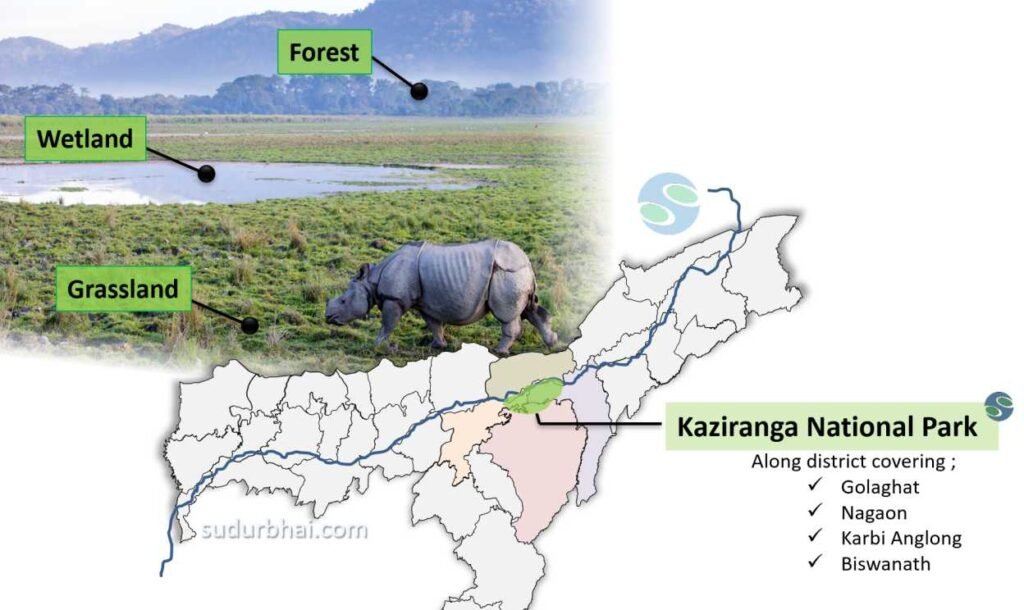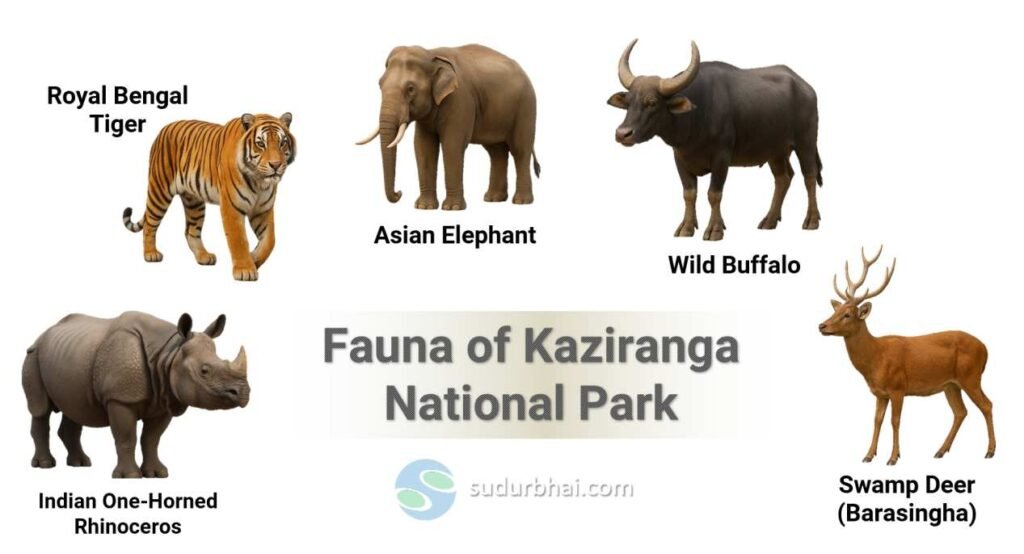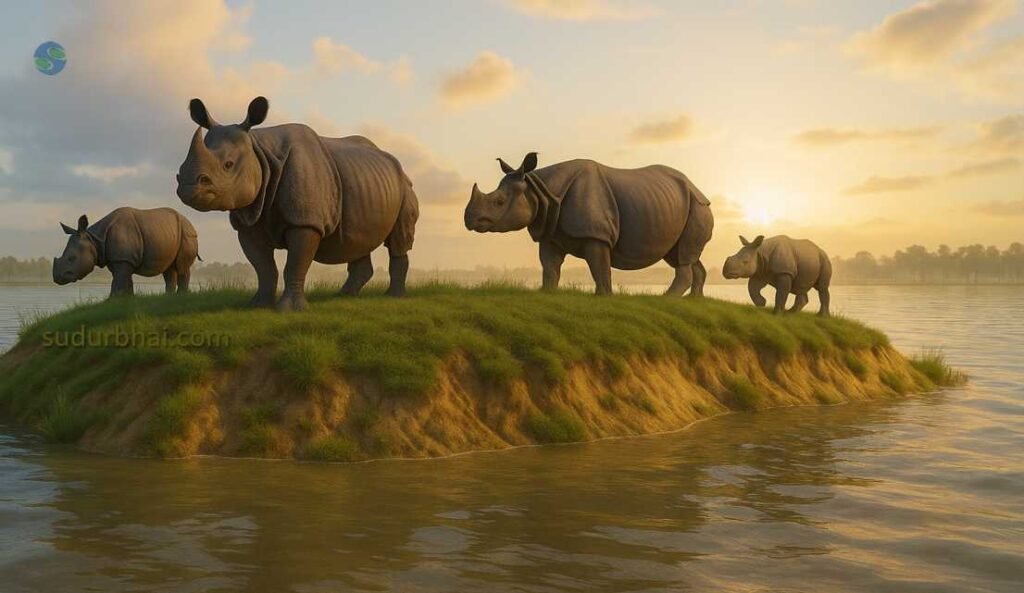Kaziranga National Park

1. Location and Area of Kaziranga National Park
- Geographical Location: Situated in the northeastern state of Assam, India.
Districts Covered: Nagaon, Golaghat, Karbi Anglong, and Biswanath.
Total Area: 430 sq. km
Landscape Features:
Comprises grasslands, wetlands, and forests.
Located on the floodplains of the Brahmaputra River, leading to rich alluvial soil deposition.

2. Year of Establishment of Kaziranga National Park
Initially Declared as a Reserve Forest: 1905.
Upgraded to a Wildlife Sanctuary: 1950.
Declared a National Park: 1974 under the Wildlife Protection Act, 1972.
Recognized as a Tiger Reserve: 2006 (part of Project Tiger).
3. UNESCO World Heritage Status
Declared a UNESCO World Heritage Site: 1985.
Reason for Recognition:
Home to the largest population of the Indian one-horned rhinoceros (Rhinoceros unicornis).
Exceptional biodiversity, including tigers, elephants, and swamp deer.
Unique ecosystem consisting of floodplain grasslands, swamps, and wetlands.
4. Biodiversity of Kaziranga National Park
A. Flora of Kaziranga National Park
Vegetation Types:
Alluvial Inundated Grasslands (dominant vegetation, vital for rhinos and herbivores).
Tropical Moist Mixed Deciduous Forests.
Semi-Evergreen Forests (on higher elevations).
Wetlands and Marshy Swamps (due to seasonal flooding).
Dominant Plant Species:
Grasslands: Elephant grass, Saccharum spp., Arundo donax.
Trees: Indian gooseberry, cotton tree, elephant apple, ficus species.
Aquatic Vegetation: Water hyacinth, water lilies, lotus.
B. Fauna of Kaziranga National Park
Mammals (35+ species)
Indian One-Horned Rhinoceros (Largest population in the world).
Royal Bengal Tiger (Declared Tiger Reserve in 2006).
Asian Elephant (Kaziranga is part of the Elephant Reserve network).
Swamp Deer (Barasingha).
Wild Buffalo (Important stronghold for the species).

Avifauna (Birdlife – Important Bird Area by BirdLife International)
Over 490 species of birds, including migratory birds from Central Asia and Europe.
Key Bird Species: Pelicans, Black-necked Stork, Greater Adjutant Stork, Fishing Eagles, Bengal Florican.
Reptiles & Amphibians
Assam Roofed Turtle, Reticulated Python, King Cobra, Indian Rock Python, Monitor Lizard.
Fish Species
Over 40 species, including the Golden Mahseer and various riverine fish.
5. Major Rivers and Terrain of Kaziranga National Park
A. Major Rivers through Kaziranga National Park
Brahmaputra River:
Forms the northern boundary of Kaziranga.
Leads to annual flooding, enriching soil nutrients but also causing habitat destruction.
Other Important Rivers:
Diphlu River (passes through the park, crucial for wildlife).
Mora Diphlu, Dhansiri, Diffloo (tributaries of the Brahmaputra).
B. Terrain & Climate of Kaziranga National Park
Landscape:
Predominantly flat floodplains with grassy meadows, wetlands, and dense forests.
Elevated sandbars and islands act as safe zones for animals during floods.

Elevated sandbars and islands in Kaziranga National Park Climate:
Tropical Monsoon Climate.
High rainfall (2500-3000 mm annually), making it vulnerable to flooding.
Three seasons:
- Summer (hot and humid),
- Monsoon (heavy rainfall and flooding),
- Winter (dry and cool).
6. Conservation Challenges and Successes in Kaziranga National Park
A. Conservation Challenges in Kaziranga National Park
Flooding (Annual Brahmaputra River Floods)
Causes loss of wildlife (especially rhinos, deer, and smaller mammals).
Forces animals to migrate towards Karbi Anglong hills, increasing human-wildlife conflict.
Poaching (Mainly for Rhino Horns)
Poachers target Indian rhinos for their horns, valued in illegal wildlife trade.
Anti-Poaching Measures: Increased patrolling, shoot-at-sight orders, use of drones and surveillance.
Encroachment and Habitat Loss
Expansion of human settlements near the park boundaries.
Illegal cattle grazing and land conversion for agriculture threaten biodiversity.
Human-Wildlife Conflict
Wild animals (elephants, rhinos, tigers) enter villages, leading to crop destruction and loss of human life.
Mitigation Efforts: Elephant corridors, compensation schemes, electric fencing.
Tourism Pressure
Unregulated tourism can cause disturbance to wildlife and environmental degradation.
B. Conservation Successes in Kaziranga National Park
Rise in Rhino Population
Rhino population increased from 366 in 1966 to over 2,600 (2022 Census) due to strict conservation measures.
Poaching Reduction
2022 recorded the lowest poaching incidents (only 2 cases) due to anti-poaching strategies.
Eco-Tourism and Community Involvement
Kaziranga Model of Conservation: Local communities benefit from tourism revenue.
Use of Technology in Conservation
Drones, camera traps, GPS tracking for rhinos and tigers.
Recognition as a UNESCO Heritage Site and Tiger Reserve
Ensured international funding, legal protection, and conservation prioritization.
